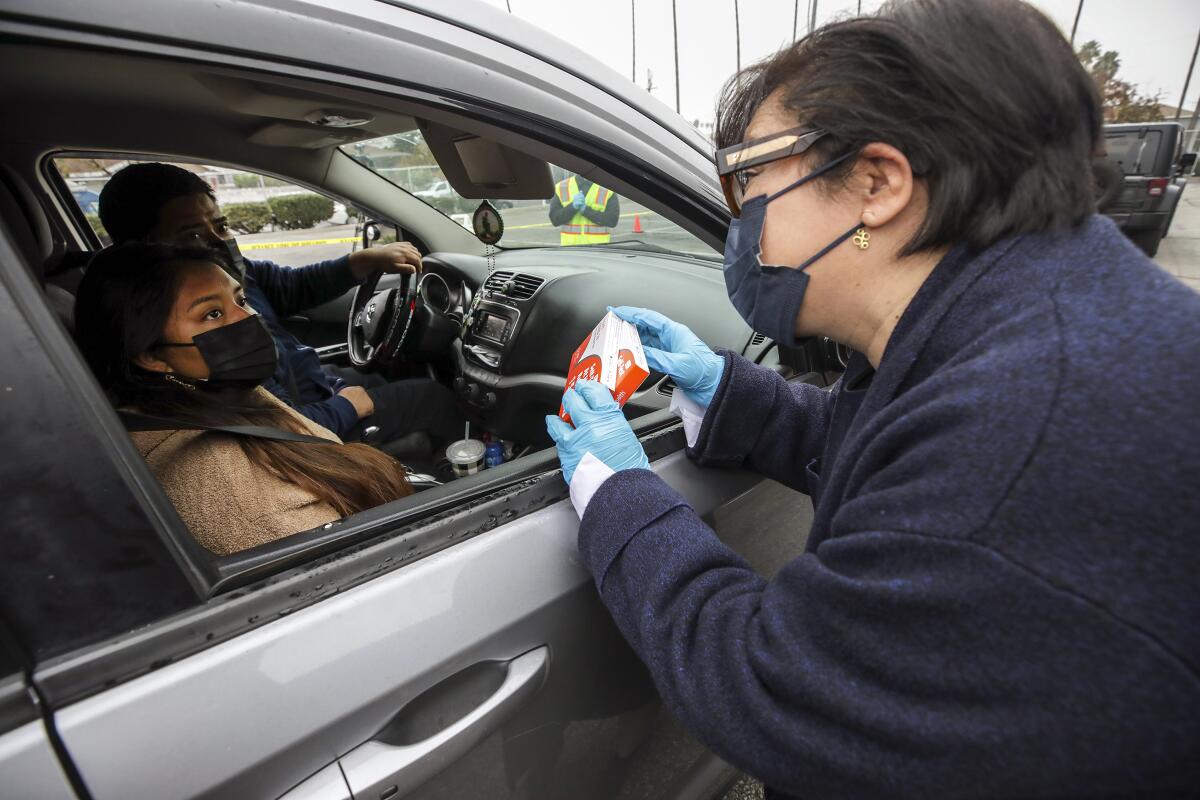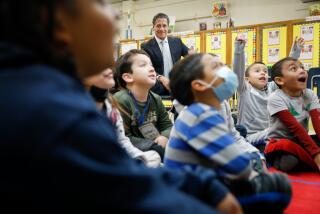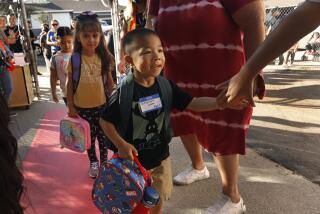LAUSD determined to open amid increase in infections; Montebello schools will delay term

- Share via
Coronavirus infection rates have shot up to 13.5% among students and staff tested this week in the Los Angeles Unified School District, a nearly 10-fold rise since before winter break, as officials said Friday that they are moving forward to safely open classrooms for in-person learning on Tuesday.
The vast majority of Los Angeles County school systems also have determined they can remain open. But Montebello Unified, the county’s third-largest district, will delay reopening by one week. And Vaughn Next Century Learning Center, an independent charter-school network with 3,300 students serving the northeast San Fernando Valley, will return to online learning for two weeks.
Through Thursday, more than half of L.A. Unified’s 73,000 employees had submitted test results and about 30% of students, said interim Supt. Megan Reilly, who visited Cochrane Middle School in Arlington Heights on Friday for the distribution of free test kits provided by the state. On Monday, Reilly required all students and staff to provide test results before returning to campus, and the district’s coronavirus testing sites have been open all week.
“We’re trying to do as much as possible to ensure we maintain the highest safety standards in our schools,” she said. “We keep our schools safer than the general public. As far as I’m concerned, I want everyone back in school.”
Montebello interim Supt. Mark Skvarna said he, too, wants all students in school but has health and logistical concerns. He worries that he may have only 30 substitute teachers available — instead of a normal 250 or so — and expects high absence rates among teachers and students, who must stay home if they test positive.
He said he decided that it is better to wait a week and add the days back later than to provide an inferior education experience and risk further transmission at the peak of the Omicron variant surge.
On Friday he posted a video message to parents.
“We’re really deeply concerned that not just having the students be ill with the virus, that having a lack of teachers in the classroom makes this problem a little bit more of something that we need to deal with immediately,” he told them. “The biggest priority of this Board of Education and the superintendent of this district is to protect the students and keep them safe — much the same as what you do as a parent.”
Like Montebello, the Vaughn K-12 charter group, which serves the Pacoima area, serves mainly Latino students from low-income families — a group hit hard by the pandemic.
“We have been monitoring the data, and the data in our area is scary,” Vaughn Chief Executive Fidel Ramirez said. “Even then, we were ready to pick up our sleeves and do what we do best, but a pattern developed.”
Vaughn, like L.A. Unified, required testing of students and staff. Early in the week, the number of infected students rose past 60 — updated lab results are pending. Among staff, 14% have tested positive.
Vaughn has an extended school year, which Ramirez hoped would help students catch up from pandemic-related learning delays. He still hopes for that, but for two weeks the effort will continue online. Students who don’t already have computers can pick them up early next week — at the same time, free food will be provided.
Teachers will instruct online from their empty classrooms. If they are healthy, teachers isolating at home also might be able to help during this temporary return to remote learning.
In L.A. Unified, the nation’s second-largest school system, teachers are scheduled to arrive on campus on Monday and students on Tuesday after a three-week winter break.
If on-campus staffing shortages arise, officials said they are prepared to deploy 4,000 employees who don’t normally work in classrooms. It will be “all hands on deck,” said spokeswoman Shannon Haber.
The L.A. Times infection tracker, which relies on data from L.A. Unified, showed a precipitous rise to 7,739 active cases as of Jan. 6, even with 70% of students not yet tested. The previous high was less than 3,000 cases, near the start of the school year. More than 200 schools are currently reporting more than 10 active cases among staff and students.
The rapid rise in infection rates mirrors what is happening in the county — and in much of the nation — due to the Omicron variant, which county health officials estimate to be five times more contagious than older strains.
The new term began this week in 50 of the 80 school systems in L.A. County.
Keeping campuses in operation has been a challenge throughout the region, as virtually all schools have had to confront high infection rates, staff absences and lower student attendance.
The L.A. Unified figures represent a snapshot of the current surge and are the product of the nation’s most extensive coronavirus testing effort — which in the fall tested all students and staff every week.
The school system had planned to ramp down from that effort — which costs about $5 million a week — before Omicron altered the equation. First, the district extended weekly testing through at least January, then called for baseline testing for the return from winter break.
L.A. Unified has a significant advantage in having the infrastructure and experience of widespread, regular testing.
The district is managing two kinds of tests — PCR tests and rapid antigen tests. The tests given to families to use at home are antigen tests.
The PCR tests are more precise in finding the presence of an infection but must be processed by a lab. A PCR test can show a positive reading before or after a person is contagious. The antigen tests are less accurate and won’t find all active infections but are reasonably effective at determining whether a person is contagious at the time of testing — and the results are ready in minutes, according to county health officials.
With the antigen tests, “you want to get that as close as possible as to the entry date,” said Anthony Aguilar, the district’s chief of special education, equity and access. “So we’re asking parents not to administer any rapid antigens any sooner than Jan. 8 to their students prior to accessing campus on Jan. 11.”
The district also is setting aside antigen tests so they can process students through as quickly as possible if they arrive to campus without clearance, Aguilar said. Parental consent is required for the district to test students, but for the vast majority this consent is on file because of last semester’s regular testing.
While taking part in the test-kit distribution Reilly emphasized that, with the antigen test, it takes just “15 minutes to basically get a result.”
Student and staff will not be allowed on campus without proof of a negative test. She expects that there will be lines of students who have not been tested awaiting access to classroom on Tuesday, but “we don’t want any student not to have access to school,” Reilly said.
Times staff writer Melissa Gomez contributed to this report.
More to Read
Sign up for Essential California
The most important California stories and recommendations in your inbox every morning.
You may occasionally receive promotional content from the Los Angeles Times.














